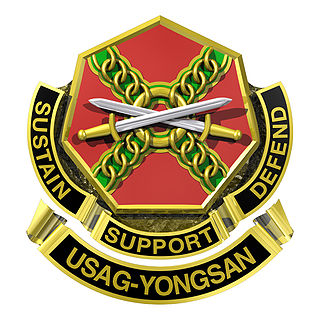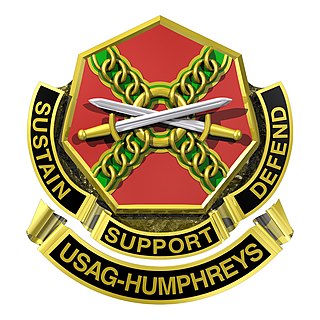
The United States Army Pacific (USARPAC) is an Army Service Component Command (ASCC) designated by the Secretary of the Army (SECARMY); it may also serve as a Joint Task Force headquarters. It is the army component unit of the United States Indo-Pacific Command, and its mission is to support the Commander, United States Indo-Pacific Command. The main areas that this command has jurisdiction in include Hawaii, Alaska, the Pacific Ocean, South Korea and Japan. It also performs missions in Southeast Asia, in the countries stretching from the Philippines all the way to Bangladesh and India. United States Forces Korea (USFK) has operational command and control on US Forces in Korea since January 2012, and USARPAC headquarters oversees the manning, training, and equipping of US Army forces assigned to USFK.

Yongsan Garrison, meaning "dragon hill garrison," is an area located in the Yongsan District of central Seoul, South Korea. The site served as the headquarters for U.S. military forces stationed in South Korea, known as United States Forces Korea (USFK), and as United States Army Garrison Yongsan (USAG-Yongsan) until 2018, under the supervision of the U.S. Army's Installation Management Command Pacific Region. From 1910 to 1945 it served as headquarters for the Imperial Japanese Army in Korea.

The American Forces Network (AFN) is a government television and radio broadcast service the U.S. military provides to those stationed or assigned overseas. Headquartered at Fort George G. Meade, Maryland, AFN's broadcast operations, which include global radio and television satellite feeds, emanate from the AFN Broadcast Center/Defense Media Center in Riverside, California. AFN was founded on 26 May 1942, in London as the Armed Forces Radio Service (AFRS).

United States Army Garrison Fort Buchanan, Puerto Rico, is a United States Army installation in Puerto Rico. It is located in the metropolitan area of the capital, San Juan.

The Eighth Army is a U.S. field army which is the commanding formation of all United States Army forces in South Korea. It commands U.S. and South Korean units and is headquartered at the Camp Humphreys, in the Anjeong-ri of Pyeongtaek, South Korea. It is the only field army in the U.S. Army.

Yongsan District is one of the 25 districts of Seoul, South Korea.

Camp Humphreys, also known as United States Army Garrison-Humphreys (USAG-H), is a United States Army garrison located near Anjeong-ri and Pyeongtaek metropolitan areas in South Korea. Camp Humphreys is home to Desiderio Army Airfield, the busiest U.S. Army airfield in Asia, with an 8,124 feet (2,476 m) runway. In addition to the airfield, there are several U.S. Army direct support, transportation, and tactical units located there, including the Combat Aviation Brigade, 2nd Infantry Division. The garrison has an area of 3,454 acres (1,398 ha) and cost US$11 billion. Camp Humphreys is the largest U.S. overseas military base, housing some 500 buildings and amenities.
Camp Casey is a U.S. military base in Dongducheon, South Korea, 40 miles (64 km) north of Seoul, South Korea. Camp Casey was named in 1952 after Major Hugh Boyd Casey, who was killed in a plane crash near the camp site during the Korean War. Camp Casey is one of several U.S. Army bases in South Korea near the Korean Demilitarized Zone (DMZ). Camp Casey, Camp Hovey, and neighboring Camp Castle and Camp Mobile hold the main armor, 7th Division of a bridging engineer company as well, and mechanized infantry elements of the 2nd Infantry Division in South Korea. Camp Castle has been largely abandoned, with only a warehouse remaining. Camp Mobile was severely damaged during a flood in July 2011, and has been abandoned except for an unmanned aerial vehicle (UAV) company. Camp Casey spans 3,500 acres and is occupied by 6,300 military personnel and 2,500 civilians. There are plans for the relocation of most of the 2nd Infantry Division to Camp Humphreys which are underway with the latest estimate for completion being 2022. The Feels Artillery Battalion remains for now at Camp Casey, while Camp Hovey is to be closed.

Camp Red Cloud was a United States Army camp located in the city of Uijeongbu, between Seoul and the Korean Demilitarized Zone (DMZ). CRC is being returned to the South Korean government. The installation was renamed after Medal of Honor recipient Corporal Mitchell Red Cloud Jr. on Armed Forces Day, May 18, 1957 from its earlier name of Camp Jackson.

The United States Army Trial Defense Service is an independent Field Operating Agency within the U.S. Army Judge Advocate General's Corps and falls under the Commanding General of the U.S. Army Judge Advocate General's Legal Center and School. The TDS motto is "Defending Those Who Defend America."

The 501st Military Intelligence Brigade is a United States Army unit, assigned to the United States Army Intelligence and Security Command (INSCOM) under the operational control of United States Forces Korea (USFK) located in South Korea. The 501st MI Brigade conducts theater level multi-discipline intelligence collection and analysis, aerial Intelligence Surveillance & Reconnaissance (ISR), and security operations in support of Eighth United States Army, U.S. Army Pacific, U.S. Pacific Command, U.S. Forces Korea, and other national level agencies.

The 607th Weather Combat Squadron of the U.S. Air Force has overall responsibility for planning, providing, and/or arranging weather support for the United States Army during armistice conditions in Korea. 607 CWS and elements of the US Navy and US Marines support the Republic of Korea Air Force (ROKAF) Weather Wing, Combined Meteorological and Oceanographic (METOC) Officer (CMO) and subordinate squadrons during exercises and contingencies. The 607 WS commander is also the Joint METOC Officer (JMO) and the senior US METOC officer (SMO) for the Korean Theater of Operations (KTO).
Camp Coiner is a former 55-acre (220,000 m2) United States Forces Korea installation located on the northern part of Yongsan Garrison located in Seoul, South Korea. It was named after 2nd Lieutenant Randall Coiner assigned to the 3rd Battalion, 31st Infantry Regiment of the 7th Infantry Division who was posthumously awarded the Silver Star for actions taken in 1953 during the Korean War near the village of Sokkagae.

The Yangju highway incident, also known as the Yangju training accident or Highway 56 Accident, was a double-homicide that occurred on June 13, 2002, in Yangju, Gyeonggi-do, South Korea. A United States Army armored vehicle-launched bridge, returning to base in Uijeongbu on a public road after training maneuvers in the countryside, struck and killed two 14-year-old South Korean schoolgirls, Shin Hyo-sun and Shim Mi-seon.

The United States Army Installation Management Command Korea Region (IMCOM-K) was a military organization whose primary mission is to provide the United States Army in Korea the installation capabilities and services to support expeditionary operations in a time of persistent conflict, and to provide a quality of life for Soldiers and Families commensurate with their service. IMCOM-Korea was the Korean regional office of the Installation Management Command. IMCOM-K had its headquarters in Seoul, Republic of Korea on United States Army Garrison Yongsan. However, IMCOM Korea was deactivated and absorbed into IMCOM Pacific in 2011.

The 65th Medical Brigade is a medical brigade of the United States Army subordinate to the Eighth United States Army and located at USAG Humphreys in South Korea.
Camp Page also known as K-47 Air Base was a former US Army base located near Chuncheon, South Korea which was closed on 1 April 2005. It enclosed 157.2 acres in North Central South Korea, near Chuncheon City, 48 miles north of Seoul, in the Kangwon province. As of 5 February 2018, the only remaining structure on the site of the former Camp Page is the water tower. The site is being developed into an urban park.
Camp Market is an installation of the United States Army, based on USAG Yongsan and it is situated in Bupyeong District, Incheon, South Korea. It is around halfway between Yongsan Garrison and the Port of Incheon, 30 miles to the west. The camp is not usually operated by U.S. Army divisions, except the 55th Military Police Company, which settled permanently in this camp. Unlike most Eight Army camps in South Korea, it is a supply depot. It is operated by civilian forces, mostly Korean nationals.It is now used as an AAFES Bakery and AAFES Distribution Center.
Seoul American High School often abbreviated as SAHS was a secondary school in Yongsan Garrison, Seoul, South Korea operated by the Department of Defense Education Activity (DODEA).
















